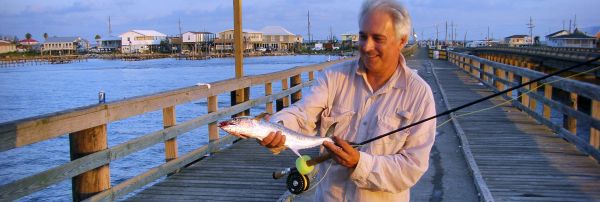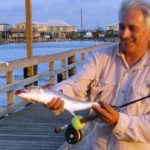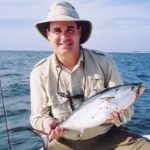
Nearshore options for summer pelagics
How fast can an ostrich run?
You may ask, “Who cares?” But believe me, not knowing really used to keep me awake some nights.
Well, we may now have an answer — 21.5 miles per hour.
You might think that this was simple. Just record a moving ostrich on a radar gun. Turns out it’s a bit tricky. While these giant birds do run fast, it’s never in a straight line.
Part of the answer came in research done by the Royal Veterinary College in England. Scientists there had the ostriches run on treadmills.
Some of you are wondering how you get ostriches to stay on treadmills. That’s simple, you give them some headphones and really cool music to run to.
Meanwhile, I’m wondering if this might work for king mackerel (I suspect a lack of legs might be a problem).
I know kings are fast. Discovered that the first time I hooked one on the fly.
While on family vacation, I was wade-fishing the Pensacola surf before sunrise when I spotted a large flash in the vicinity of my fly. Within seconds, the “flash” had stripped all the line and a significant part of my backing into the emerald water. It then went airborne, and I immediately recognized it as a king in the 40-pound range.
How that fish didn’t cut me off instantly, given I was using a 20-pound mono bite tippet, I’ll never know. It would have probably saved my flimsy reel, which after that incident never was the same.
I learned two lessons that day. First, you need quality tackle to chase pelagics. Second, hooking fast fish is addictive.
Unfortunately, like most addictions, chasing pelagics can be costly.
With two exceptions, it requires a big boat. Unfortunately, the overwhelming majority of Louisiana saltwater fly anglers own skiffs or kayaks or both — the best means for hunting down the Spottail Elvis in shallow marsh.
For shallow-oriented fly anglers wanting to take on fast-and-furious action, the first option is to head east to the emerald waters of northwest Florida.
Due to a lack of major rivers, favorable currents and close proximity to the deep DeSoto Canyon, the beaches from Pensacola to Panama City hold a wide variety of pelagics. I’ve caught Spanish, small kings, jacks, barracuda, cobia, bonito and bluefish either wading or from a kayak.
If that’s not enough, every year there are several mahimahi and sailfish caught off the Okaloosa, Navarre and Pensacola fishing piers. I once hooked a large tarpon on a fly from the Navarre Pier. It was a short but very exhilarating experience, to say the least.
I mentioned there’s a second option for nearshore anglers to experience these fish. And that’s right here in Louisiana.
In late summer, the major rivers reach their annual low, and typically one or two tropical storms push “Gulf water” up to the beaches. At those times, it’s fairly common for schools of bluefish, Spanish, jack crevalle, barracuda and even a few kings to be swimming in the surf at Grand Isle and Fourchon. Or in the passes on an incoming tide.
Large jacks even invade Lake Pontchartrain.
These fish will test both your skill and your tackle.
For blues, Spanish and bonito, an 8- or 9-weight rod is sufficient, but larger species require at least a 10-weight rig. Unless you enjoy spending a day on the water fighting one fish, you might even think 12-weight for jack crevalle.
In most cases, a clear intermediate-sinking fly line is a better choice than a floating line. Unless there’s a surface feeding frenzy — you definitely want poppers for that.
Most pelagics have razor-sharp teeth, so a bite tippet of 12 inches of a flexible, nylon-coated wire is recommended. I’ve found black is better than “brite” for leader-shy fish. For Spanish and blues, when wire doesn’t seem to work I’ve found a double-line tippet using 40-pound fluorocarbon will work, at least for a few fish.
Flies are ultimately doomed to the choppers from hell. But those tied with ultrahair and other synthetics have a bit longer life span. Anything that resembles baitfish will work. Deceivers, Clousers, Seaducers and EP Flies are solid choices.
The most important tackle is the fly reel.
A king can reach speeds up to 40 mph, and studies show that even when eating its prey, it’s traveling about 15 mph. Large Spanish aren’t a whole lot slower, moving up to 32 mph. And no, these fish were not treadmill-timed.
Such fast, hard-hitting denizens require a reel with excellent drag, very low start-up inertia, and high tolerances. A large carbon fiber drag is best. The reel must also hold at least 200 yards of backing.
Then there’s the retrieve. A fish that swims over 25 mph wants fast food — really fast food. The regiment is to cast out, then strip like mad.
Using a heavily weighted fly helps give up-and-down motion that imitates the evasive maneuvers of a baitfish.
For retrieve, a two-handed technique works really well. Place the rod under one arm, and use both hands to strip 16 to 24 inches a second.
Another technique to get more strikes is to make big strips with the rod pointed to your left, then sweep the rod up and to your right as you continue stripping. This moves the fly side-to-side.
Be careful. Once the fish eats, and you set the hook, all that speed will be put to use. Bruised knuckles are common due to the high rotation of the fly spool as line melts off the reel . Wearing gloves helps, but keeping your fingers away from the reel helps more.
Are you ready for extreme fly fishing? Warning — it could be addictive.


